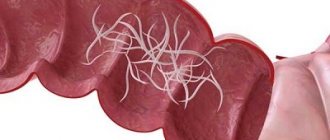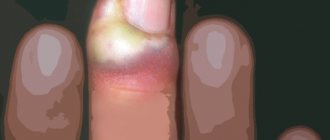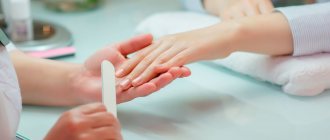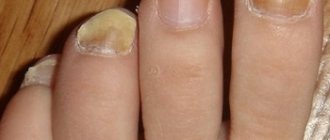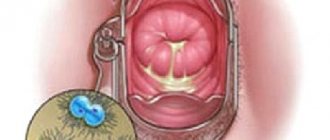In addition, the appearance of edema may indicate the presence of fungal or infectious diseases. When blood flow in the lower extremities is disrupted, blood begins to accumulate, which leads to swelling of the toe and its pain. Sometimes such problems can arise due to an ingrown toenail, but then the entire foot begins to swell along with the toes. Only the attending physician can eradicate the source of the disease. By removing part of the ingrown toenail, the symptoms will immediately disappear.
The presence of a splinter or thorn in a finger can also cause your toes to swell and hurt. After all, the infectious process can begin when a foreign body enters the finger. First of all, you need to figure out what caused the swelling of your fingers and begin to immediately take measures to eliminate them.
What diseases cause swelling in the toes?
Various types of diseases can also cause pain and swelling. These include pathologies such as:
1. Arthritis. An increase in size and limited mobility of one or more fingers may indicate the appearance of this disease, which causes degenerative disorders in cartilage tissue. The development of arthritis is provoked by the presence of excess weight in people, flat feet, and heavy physical work. It is not surprising that athletes often have swollen lower limbs, as they regularly receive injuries, bruises and sprains. At the second stage of development of the pathology, damage to the joints of the fingers occurs, so any delay entails great consequences. Without proper treatment, the patient's condition will worsen, ultimately leading to disability. You should immediately consult a doctor and undergo a full physical examination if you experience swelling and pain in your big toe.
2. Arthrosis. One of the most common symptoms of this disease is swelling of the toe near the nail. This joint pathology is characterized by a destructive effect on cartilage. At the beginning of the disease, the pain is periodic, but eventually becomes chronic. Osteoarthritis often begins with pain in the big toe, which disappears with rest. In the morning, patients experience a certain degree of stiffness, difficult functioning of the joints, as well as a crunching sensation. Signs of arthrosis such as limited mobility and chronic pain overlap with the symptoms of subchondral sclerosis and epicondylitis. If an infection appears in the joints, then arthrosis becomes infectious.
3. Osteoporosis. With the development of this disease, bones lose strength and mass, which is due to pathological processes that make bone tissue fragile and cause swelling. Patients with osteoporosis should treat their fingers carefully and with caution, because any careless movement can lead to a fracture. At the beginning of the development of the pathology, the toe swells and begins to hurt, and after a while deformation occurs with the foot.
4. Symptoms when the joint of the big toe is swollen and painful, and also red, may indicate the development of a disease such as bursitis. Severe bruises and advanced stages of arthrosis can cause its appearance. When a joint is affected, the space between the bones and muscles becomes inflamed and filled with fluid. If the pathology is not treated, the disease becomes chronic and the pain becomes permanent. To confirm the diagnosis, the patient undergoes a fluid tap, MRI, and x-ray in addition to a visual examination.
5. The development of gout can be caused by a malfunction of metabolic processes in the body. This pathology is more common among men than women. At the initial stage of the pathology, the toes swell, and later the phalanges of the fingers can completely collapse. Swelling and pain are paroxysmal in nature
6. Ankle injury. When there is a lot of stress on the legs, the most vulnerable place is the little toe. For example, it can be damaged by hitting a furniture leg or door frame, or by wearing tight shoes. After the blow, the little finger begins to swell and hurt. In general, bruises do not pose any danger to humans. However, the negative impact can manifest itself in the form of chronic pain or the development of not the most pleasant diseases. If after the blow the finger is swollen and painful, then it is necessary to undergo a medical examination.
7. Swelling of the fingers can also be caused by an allergic reaction. If the legs are constantly itching, itching and discomfort appears, then the human immune system begins to react to irritating factors and produce chemicals that cause swelling. All symptoms will go away only if the external irritant is neutralized.
8. Diabetes mellitus. Swelling of the legs in this disease is provoked by metabolic disorders. Typically, patients experience pain and blue toes. In addition, the sensitivity of the lower extremities decreases, there is numbness in the fingers and a burning sensation in the feet. If such symptoms are observed, you should immediately contact an endocrinologist so that the doctor can conduct an examination and prescribe the most appropriate treatment.
9. Panaritium. This pathology appears due to infectious infection. The symptoms are clearly visible, which begin with suppuration of the nail, are characterized by pain and swelling of the finger, and cysts with purulent contents form. A blister and swelling may be seen on the phalanx. In addition, sensitivity disturbances and capillary blockage occur. In this case, herbal baths can help, but the disease can be completely cured only after opening the cysts and completely removing the purulent contents.
Treatment
Help before diagnosis
For injuries, elevate the foot and apply an ice pack or a heating pad with cold water. Fractures are fixed with a splint or a special bandage. Patients with frostbite are treated with insulating bandages. For non-traumatic lesions, the leg is given rest, and local anesthetics and anti-inflammatory drugs are sometimes used.
Conservative therapy
Dislocations are reduced; in case of displaced fractures, reposition is performed and immobilization is carried out. For pain in the fingers, the following conservative measures can be used:
- Protective mode
. The patient is recommended to limit the load on the limb, use orthopedic products or special devices (cane, crutches). - Drug therapy
. For inflammatory and degenerative processes, NSAIDs are prescribed. Infectious diseases are an indication for antibiotic therapy. For vascular diseases, drugs to improve blood circulation are effective. - Non-drug methods
. UHF, medicinal electrophoresis, magnetic therapy, and other physiotherapeutic techniques may be indicated. Some patients are recommended exercise therapy and massage.
Which doctor should I contact?
To determine the reason why your toe hurts and is swollen, as well as to treat this problem, you need to consult a doctor. The first step is to visit a therapist, who can prescribe treatment or refer you to a more highly qualified specialist. Swelling of the extremities can also be caused by heart disease, therefore, to exclude this cause, the patient should be examined by a surgeon or rheumatologist. An orthopedist will help solve the problem of foot deformities, and an endocrinologist will prescribe treatment for hormonal imbalances. If the condition is the result of an injury, then you should visit a traumatologist who will identify the essence of the problem. An accurate diagnosis and treatment are possible only after studying the symptoms of the disease and analyzing the patient’s condition.
Before a consultation with a doctor is scheduled, you can relieve the pain on your own. To prevent your toes from hurting, you can apply heat or cold to them (when they burn and turn red). At home, you can use both medications and traditional medicine.
Traditional methods of treatment for the treatment of panaritium on the leg
To increase the effectiveness of foot treatment and quickly eliminate panaritium, it is recommended to use traditional recipes. They accelerate tissue metabolism, which increases the regeneration of epithelial cells. In addition, increasing local immunity ensures the prevention of relapse.
Chicken protein
You can use the recipe regardless of age, health restrictions - individual intolerance to the ingredients.
For the recipe you need to break an egg and separate the white into a narrow container. Then you need to gradually add alcohol to it, stirring thoroughly until white flakes begin to form.
After this, you need to strain the solution through cheesecloth. The liquid is applied to gauze or a cotton pad and applied to the finger for an hour.
Copper sulfate
Copper sulfate will help relieve pain that develops when the toes are affected.
You need to take the substance at the tip of a knife and dissolve it in two tablespoons of warm boiled water. The solution is used as a bath; you need to keep the sore finger in it for 15 minutes.
Treatment continues daily until symptoms are completely eliminated.
Soda against felon
Baking soda is also often used to neutralize felon, as it has a strong antiseptic effect. There are no contraindications to the use of the product, so it is sometimes used as a prophylaxis.
To make a soda steam bath, three components are used:
- Warm boiled water – 1 liter;
- Baking soda – 50 grams;
- Table or sea salt – 40 grams.
Mix the ingredients and soak a cotton pad in the prepared solution, placing it on the panaritium for half an hour. Then you need to wipe your feet with a disposable paper towel.
How to prevent the disease
Basic preventive measures help prevent swelling in the toes. You just need to take care of your body and try to avoid the possibility of injury. The key to good foot health will be personal hygiene, which should be present in every person's life on an ongoing basis.
Particular attention should be paid to the choice of comfortable, high-quality shoes, which should be made from natural materials, and also have a not very high heel and a comfortable sole. In addition, you can use special orthopedic shoes or insoles. If fungal or other diseases are detected, treatment should be started immediately.
You should also monitor your diet so that it is complete and includes all the necessary microelements obtained from foods. It is necessary to reduce the amount of salt consumed, as it prevents excess water from leaving the body, which causes edema. It is also better to abstain from drinking alcohol or reduce it to a minimum.
Swelling of the fingers is easy to treat and is often completely eliminated, but only if treatment was provided in a timely manner. By following basic rules, you can prevent the formation of edema and also maintain your health.
Antibiotics for felon on the leg
Panaritium is a serious viral disease that is quite difficult to eliminate using gentle medications. Because of this, the doctor prescribes strong antibiotics that have an anti-inflammatory effect to gradually heal the tissue and eliminate purulent discharge under the skin.
Azithromycin
The drug is most often prescribed for initial and active forms of development of the defect, when felon does not greatly affect the condition of the epidermis of the legs.
The advantage of the product is a minimal course of rehabilitation. Typically, a girl should take the drug in tablet form once a day for three days. If the treatment does not completely destroy the viral bacteria, the dose may be doubled, then it is recommended to take two tablets of the active ingredient at once.
There are two health restrictions: renal failure and individual intolerance to the components contained in the composition.
Sumalek
It is similar to the previous drug, since it should also be taken once a day for three days. However, the dose should be taken at the same time every day - an hour after breakfast or lunch, so that the active substances have the most effective effect on pathogenic microflora.
If the girl does not begin treatment for felon immediately, the recovery period can be doubled, or the dose of the active substance can be increased.
Ziromin
The antibiotic should be used only for infectious diseases accompanied by inflammatory processes. If you have a virus, you cannot use Ziromin.
The drug is taken once a day at the same time. The course of treatment usually lasts 5 days.
Be careful when combining an antibiotic with other medications, as they may react and have the opposite effect. Anti-panaritium ointments on hands
Most often, to cure felon, it is necessary to use anti-inflammatory ointments that suck out pus from the structure of the epidermis and eliminate pathogenic bacteria. The ointment can be combined with tablets for oral administration, so you will speed up the healing period of your legs.
Ichthyol ointment
Quite often used in the treatment of any purulent lesions. Panaritium can also be eliminated using ichthyol if you undergo a course of treatment of two weeks.
The active component of the composition penetrates the structure of the epidermis, regardless of the shape and characteristics of pathogenic bacteria. Ichthyol ointment prevents thinning and deterioration of the quality of the skin, gradually removing toxins.
It should be used 1 or 2 times a day, applied to gauze folded several times and applied to the finger, securing with an adhesive plaster.
Levosin
Levosin is used to treat any inflammation and suppuration on the skin, as it has two directions of action: it eliminates pathogenic microorganisms and relieves inflammation, which can lead to their proliferation.
You need to apply the ointment on a napkin or cotton pad, securing it to the surface of the plate with an adhesive plaster. You need to continue using Levosin until you completely remove the panaritium. Typically this takes 10-14 days.
Tetracycline ointment
The first symptom that tetracycline neutralizes is pain while walking and redness, since the active substance has an anti-inflammatory effect. After 2-3 days of using the ointment, the swelling of the damaged area subsides.
It is also recommended to use tetracycline as a compress, changing it 1 or 2 times a day. Treatment lasts two weeks.
Keep in mind that there is one health limitation - kidney dysfunction. If there are problems with the organs, it is recommended to reduce the dosage of the drug or replace it altogether.
Syntomycin ointment
The drug is used only to treat panaritium in an advanced stage of development, since it has a rather aggressive effect on the skin and can cause side effects if the dosage is not followed.
The ointment is applied to gauze and applied to the nail. However, keep in mind that you need to apply the smallest possible amount of product. The bandage needs to be changed twice a day. Synthmycin ointment is used only by adults, since treatment with it in childhood can lead to damage to sensitive skin.
Lotions against felon on the toe
Doctors also often recommend using lotions that will speed up the elimination of inflammatory processes and increase local tissue immunity.
Dermasept gel
It has a gentle effect on felon, therefore it is used as an antiseptic, gradually destroying the cell membrane of microbes.
The gel is applied to a napkin and applied to the nail bed until completely dry, which occurs after 30-40 minutes. The procedure can be repeated 2 or 3 times a day.
There are no health restrictions for the gel, but it should only be used in complex therapy, because it will not be possible to remove panaritium with dermasept as a stand-alone drug.
Antisept
It is necessary to begin treating felon developing on the legs immediately after the first signs of symptoms appear, since the antiseptic prevents the further spread of the defect.
Antisept should be used in the same way as the previous gel, applied to a loose napkin and placed on the nail until dry - 2-3 times a day.
Keep in mind that increasing the dosage of the drug may cause swelling, which is why you must strictly follow the doctor’s instructions.
Causes
The main provoking factor of infection is the penetration of pathogenic microorganisms into the wound surface. Among the most common are the following:
- enterococcus;
- Staphylococcus aureus;
- fungal infections;
- beta-hemolytic streptococcus;
- Pseudomonas aeruginosa and Escherichia coli.
Often the inflammatory process is provoked by a combination of several varieties of anaerobic and aerobic pathogenic bacteria.
In most cases, infection occurs through microtraumas and various lesions on the skin. Against the background of this condition, the listed types of pathogenic microflora enter the inner dermal layers and continue to multiply. As a result, suppuration appears, which will be facilitated by the lack of appropriate treatment of the wound surface.
According to statistics, in 10-20% of cases, when visiting a specialist, the patient complains of an infectious process in the area of the big toe. Due to certain features of its structure, in most cases it is it that is damaged.
Other pathological conditions can also provoke panaritium of the legs. Among the most common ones are:
- tendency to an allergic reaction;
- diabetes;
- hormonal disorders;
- decreased immune system;
- fungal infections;
- vascular diseases.
In addition, the cause of the disease is often a poorly performed pedicure. The likelihood of infection increases if manicure instruments are handled incorrectly or completely absent.
Consequences
A prolonged absence of therapeutic measures aggravates the course of the pathological process, resulting in an increased likelihood of developing complications such as:
- spread of suppuration in the tissue according to a diffuse type;
- development of sepsis due to the penetration of pyogenic microorganisms into the blood;
- the occurrence of necrosis ;
- total damage to all structures of the phalanx and fusion of joints;
- destruction (osteomyelitis).
In addition, if measures are not taken to eliminate the problem in a timely manner, this can lead to ingrown nail plates and inflammation of the deep layers of the epidermis.
Experts consider pandactylitis erysipelas to be one of the most serious consequences. This is a pathological condition in which purulent processes spread to all tissue structures of the finger. The disease is manifested by general intoxication and the release of characteristic exudate.
Kinds
Panaritium of the toes is classified into several varieties.
Subcutaneous
The localization site is the middle dermal layers. The development of the pathological process is facilitated by deeper lesions. The disease is accompanied by thickening of the skin in the damaged area, abscesses, and the development of inflammation deep under the skin.
Periungual panaritium is treated with antibacterial ointments, broad-spectrum antibiotics (if the process spreads), antiseptics, and warm lotions to improve blood circulation.
Care must be taken to keep the affected area in dry conditions.
The danger of this type of pathology is that if left untreated for a long time, inflammation can spread to the joints, tendons and bones.
Cutaneous
This is one of the most common forms of the disease. Its development occurs against the background of damage to the upper layer of the epidermis. In the pathological location, the formation of one or several papules is noted, the cavity of which contains purulent contents. Sometimes blood may be present in the fluid. There is also redness of the skin around the bubble.
Very often, in everyday conditions, panaritium can be caused by a fish bone getting into the soft tissue of a finger during the process of cutting fish.
When visiting nail salons, it is preferable to use individual accessories for treating nail plates.
Cosmetologist, dermatologist, trichologist
Kalinina Olga Alexandrovna
4 years of experience
This condition is characterized by burning and pain. As the disease progresses, the symptoms intensify, which indicates infectious damage to the deeper layers of tissue structures.
Cutaneous panaritium is easy to treat and almost never becomes complicated, since more skin is involved in the pathological process. When a patient tries to pierce a pustule on his own, in the absence of timely treatment, the inflammation intensifies and spreads to the lymphatic vessels.
Subungual
This type of disease occurs when a splinter or needle gets under the nail. This form is somewhat more dangerous than the periungual form, since infection affects not only the surface of the plate, but also its internal structures.
Once pus gets into the tissue, it cannot come out. As a result, the nail is destroyed and deeper layers are damaged.
Periungual
The inflammatory process affects the skin fold located around the nail plate. The reason for the development of this condition may be a pedicure when the specialist does not use disinfectants to treat instruments. Also among the provoking factors are burrs and small cracks through which infection can occur.
This form is characterized by damage to the ridge around the nail plate, the appearance of ulcers of dense consistency, and brown skin color.
Articular
The cause of felon in this case is:
- infection from bone or soft tissue;
- internal fractures in the phalanges;
- damage to the bursa in the joint.
The danger of this form of pathology is that when the capsule suppurates, its tissue begins to collapse. As a result, the motor activity of the phalanx is limited, which requires immediate amputation surgery.
During palpation, pronounced tension of the joint capsule can be detected. Swelling of the finger is also observed.
Bone
This is an independent disease, or a complicated form of the subungual and subcutaneous type of panaritium. Against the background of infection, gradual destruction of the bone occurs, which is accompanied by severe pain of a pulsating nature.
Why can our articles be trusted?
We make health information clear, accessible and relevant.
- All articles are checked by practicing doctors.
- We take scientific literature and the latest research as a basis.
- We publish detailed articles that answer all questions.
The phalanx swells, the skin becomes tense, the surface becomes smooth with a purple or red color. The finger almost completely stops moving, resulting in severe pain.
Bone panaritium is characterized by clinical signs such as general weakness, chills, and fever.
Tendinous
This is the most dangerous type of pathology due to the structural features of the tendons. Against the background of the disease, rapid infection of collagen fibers and fibrous tissue occurs. Pathogenic microorganisms involve soft, bone structures and joints in the process.
WHEN YOU SHOULD SOUND THE ALARM, THE FIRST SYMPTOMS OF felon
There are two forms of the disease:
- Purulent form;
- Serous form, in which swelling is more pronounced.
The panaritium of the finger is formed at the site of a microtrauma that has become infected. Swelling, hyperemia and painful sensations of a pulsating nature appear. Symptoms of general malaise and fever may also develop.
Tendon panaritium.
With articular and bone panaritium, the joint and bone of the phalanx of the finger are involved in the purulent process. The symptoms of bone and articular felon are similar to those of subcutaneous felon, but more pronounced. The swelling usually spreads throughout the finger. The pain is strong, intense and cannot be clearly localized, the finger is bent, movements are impossible due to pain and swelling. Spontaneous breakthrough of pus through the skin with the formation of purulent fistulas is possible. In the case of articular panaritium, swelling, redness and pain are initially localized around the affected joint, but if left untreated, they spread to the entire finger.
A typical clinical picture is shown in the photo.
